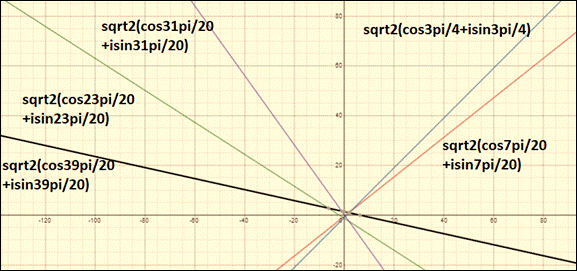
a.
To calculate:
The roots of
a.
Answer to Problem 122E
The roots of the complex numbers are,
Explanation of Solution
Given information:
Fifth roots of
Formula used:
Where,
complex number
Calculation:
Consider the
The complex number
Its modulus is given by
Its argument is
As the complex number lies in the fourth quadrant, therefore
Hence, its trigonometric form comes out to be
Therefore, the given complex number is
By using the formula for
For a positive integer
So, by using the formula the result is as follows:
So, for
For
For
For
For
For
b.
To calculate:
Given roots in standard form.
b.
Answer to Problem 122E
The complex roots are in the standard form as,
Explanation of Solution
Given information:
Fifth roots of
The roots are,
Calculation:
Since,
For,
As know that sine is positive and cosine is negative in the second quadrant, so
For,
As know that sine and cosine are negative in the third quadrant, so
For,
As know that cosine is positive and sine is negative in the fourth quadrant, so
For,
As know that cosine is positive and sine is negative in the fourth quadrant, so
c.
To graph:
The given roots graphically.
c.
Explanation of Solution
Given information:
The roots are,
Graph:

Interpretation:
In above graph, complex roots are described.
Chapter 6 Solutions
PRECALCULUS W/LIMITS:GRAPH.APPROACH(HS)
 Calculus: Early TranscendentalsCalculusISBN:9781285741550Author:James StewartPublisher:Cengage Learning
Calculus: Early TranscendentalsCalculusISBN:9781285741550Author:James StewartPublisher:Cengage Learning Thomas' Calculus (14th Edition)CalculusISBN:9780134438986Author:Joel R. Hass, Christopher E. Heil, Maurice D. WeirPublisher:PEARSON
Thomas' Calculus (14th Edition)CalculusISBN:9780134438986Author:Joel R. Hass, Christopher E. Heil, Maurice D. WeirPublisher:PEARSON Calculus: Early Transcendentals (3rd Edition)CalculusISBN:9780134763644Author:William L. Briggs, Lyle Cochran, Bernard Gillett, Eric SchulzPublisher:PEARSON
Calculus: Early Transcendentals (3rd Edition)CalculusISBN:9780134763644Author:William L. Briggs, Lyle Cochran, Bernard Gillett, Eric SchulzPublisher:PEARSON Calculus: Early TranscendentalsCalculusISBN:9781319050740Author:Jon Rogawski, Colin Adams, Robert FranzosaPublisher:W. H. Freeman
Calculus: Early TranscendentalsCalculusISBN:9781319050740Author:Jon Rogawski, Colin Adams, Robert FranzosaPublisher:W. H. Freeman
 Calculus: Early Transcendental FunctionsCalculusISBN:9781337552516Author:Ron Larson, Bruce H. EdwardsPublisher:Cengage Learning
Calculus: Early Transcendental FunctionsCalculusISBN:9781337552516Author:Ron Larson, Bruce H. EdwardsPublisher:Cengage Learning





